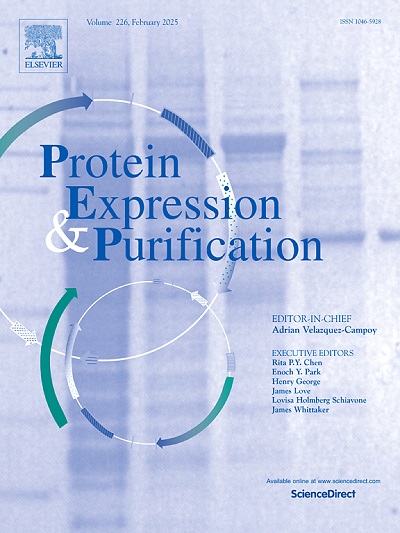Expression and purification of functional recombinant Cullin1-Rbx1/2 in E. coli
IF 1.2
4区 生物学
Q4 BIOCHEMICAL RESEARCH METHODS
引用次数: 0
Abstract
Protein ubiquitination is a crucial post-translational modification in eukaryotes that is mediated by E1-E2-E3 enzymatic cascades and regulates a wide range of cellular processes. Cullin-RING E3 ligases (CRLs) represent the largest family of RING-type E3 ligases and play pivotal roles in these processes. Generating full-length, active Cullin1-Rbx1 (CRL1) is essential for biochemical and biophysical investigations. In this study, we developed an efficient strategy to produce functional CRL1 complexes from E. coli, by fusing an MsyB protein to N-terminus of Cullin1 to improve its solubility. The recombinant CRL1 demonstrated full functionality, successfully assembling with substrate receptor Skp1-Skp2-Cks1 and mediating the polyubiquitination of Ub-p27-degron substrate. Using recombinant CRL1, we found that phosphorylation at Ser65 inhibited the CRL1-UBE2R1 mediated ubiquitin chain elongation on Ub-p27-degron. Furthermore, using the same strategy, we successfully generated Cullin1-Rbx1 mutants and Cullin1-Rbx2 complexes, thereby expanding the applicability of our method. Collectively, this work establishes a rapid and cost-effective platform for the production of CRL1 complexes, facilitating structural and functional studies.
功能性重组Cullin1-Rbx1/2在大肠杆菌中的表达与纯化
蛋白泛素化是真核生物中一个重要的翻译后修饰,由E1-E2-E3酶级联介导,并调节广泛的细胞过程。Cullin-RING E3连接酶(CRLs)是最大的ring - E3连接酶家族,在这些过程中起着关键作用。产生全长、活性的Cullin1-Rbx1 (CRL1)对于生物化学和生物物理研究至关重要。在这项研究中,我们开发了一种从大肠杆菌中产生功能性CRL1复合物的有效策略,通过将MsyB蛋白融合到Cullin1的n端来提高其溶解度。重组CRL1显示出完整的功能,成功地与底物受体Skp1-Skp2-Cks1组装,并介导Ub-p27-degron底物的多泛素化。利用重组CRL1,我们发现Ser65位点的磷酸化抑制了CRL1- ube2r1介导的ub -p27 degron上泛素链的延伸。此外,使用相同的策略,我们成功地生成了Cullin1-Rbx1突变体和Cullin1-Rbx2复合物,从而扩大了我们方法的适用性。总的来说,这项工作为CRL1复合物的生产建立了一个快速和经济的平台,促进了结构和功能的研究。
本文章由计算机程序翻译,如有差异,请以英文原文为准。
求助全文
约1分钟内获得全文
求助全文
来源期刊

Protein expression and purification
生物-生化研究方法
CiteScore
3.70
自引率
6.20%
发文量
120
审稿时长
32 days
期刊介绍:
Protein Expression and Purification is an international journal providing a forum for the dissemination of new information on protein expression, extraction, purification, characterization, and/or applications using conventional biochemical and/or modern molecular biological approaches and methods, which are of broad interest to the field. The journal does not typically publish repetitive examples of protein expression and purification involving standard, well-established, methods. However, exceptions might include studies on important and/or difficult to express and/or purify proteins and/or studies that include extensive protein characterization, which provide new, previously unpublished information.
 求助内容:
求助内容: 应助结果提醒方式:
应助结果提醒方式:


